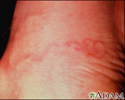Creeping eruption
Parasite infection - hookworm; Cutaneous larvae migrans; Zoonotic hookworm; Ancylostoma caninum; Ancylostoma braziliensis; Bunostomum phlebotomum; Uncinaria stenocephala
Creeping eruption is a human infection with dog or cat hookworm larvae (immature worms).
Hookworm
Hookworm infection is caused by roundworms. The disease affects the small intestine and lungs.

Causes
Hookworm eggs are found in the stool of infected dogs and cats. When the eggs hatch, the larvae can infest soil and vegetation.
When you come into contact with this infested soil, the larvae can burrow into your skin. They cause an intense inflammatory response that leads to a rash and severe itching.
Inflammatory response
The immune response is how your body recognizes and defends itself against bacteria, viruses, and substances that appear foreign and harmful....

Rash
Rashes involve changes in the color, feeling or texture of your skin.

Creeping eruption is more common in countries with warm climates. In the United States, the Southeast has the highest rates of infection. The main risk factor for this disease is contact with damp, sandy soil that has been contaminated with infected cat or dog stool. More children than adults are infected.
Symptoms
Symptoms of creeping eruption include:
-
Blisters
Blisters
A vesicle is a small fluid-filled blister on the skin.
 ImageRead Article Now Book Mark Article
ImageRead Article Now Book Mark Article - Itching, may be more severe at night
- Raised, snakelike tracks in the skin that may spread over time, usually about 1 cm (less than one half inch) per day, usually on the feet and legs (severe infections may cause several tracks).
Exams and Tests
Your health care provider can often diagnose this condition by looking at your skin. In rare cases, a skin biopsy is done to rule out other conditions. In very rare cases, a blood test is done to see if you have increased eosinophils (a type of white blood cell).
Skin biopsy
A skin lesion biopsy is when a small amount of skin is removed so it can be examined. The skin is tested to look for skin conditions or diseases. A...

Eosinophils
An absolute eosinophil count is a blood test that measures the number of white blood cells called eosinophils. Eosinophils become active when you ha...

Treatment
Anti-parasitic medicines may be used to treat the infection.
Outlook (Prognosis)
Creeping eruption often goes away by itself over weeks to months. Treatment helps the infection go away more quickly.
Possible Complications
Creeping eruption may lead to these complications:
- Bacterial skin infections caused by scratching
- Spread of the infection through the bloodstream to the lungs or small intestine (rare)
When to Contact a Medical Professional
Make an appointment with your provider if you or your child have skin sores that are:
- Snake-like
- Itchy
- Moving from one area to another.
Prevention
Public sanitation and deworming of dogs and cats have decreased hookworm infestation in the United States.
Hookworm larvae often enter the body through bare feet, so wearing shoes in areas where hookworm infestations are known to occur helps prevent infection.
References
Habif TP. Infestations and bites. In: Habif TP, ed. Clinical Dermatology . 6th ed. Philadelphia, PA: Elsevier; 2016:chap 15.
Nash TE. Visceral larva migrans and other uncommon helminth infections. In: Bennett JE, Dolin R, Blaser MJ, eds. Mandell, Douglas, and Bennett's Principles and Practice of Infectious Diseases, Updated Edition . 8th ed. Philadelphia, PA: Elsevier Saunders; 2015:chap 292.
-
Hookworm - mouth of the organism - illustration
Necator americanus
Hookworm - mouth of the organism
illustration
-
Hookworm - close-up of the organism - illustration
Ancyclostoma duodenale
Hookworm - close-up of the organism
illustration
-
Hookworm - Ancyclostoma caninum - illustration
This is a photograph of a hookworm on the lining of the intestine. (Image courtesy of the Centers for Disease Control and Prevention.)
Hookworm - Ancyclostoma caninum
illustration
-
Cutaneous larva migrans - illustration
Cutaneous larva migrans is a condition that occurs when dog or cat hookworm larvae migrate through the skin. The migration produces a raised, red, twisting (serpiginous) pattern on the skin.
Cutaneous larva migrans
illustration
-
Strongyloidiasis, creeping eruption on the back - illustration
Hookworm larvae that have migrated through the skin have caused the reddish serpiginous (snake-like) pattern on the left side of this individual's back.
Strongyloidiasis, creeping eruption on the back
illustration
-
Hookworm - mouth of the organism - illustration
Necator americanus
Hookworm - mouth of the organism
illustration
-
Hookworm - close-up of the organism - illustration
Ancyclostoma duodenale
Hookworm - close-up of the organism
illustration
-
Hookworm - Ancyclostoma caninum - illustration
This is a photograph of a hookworm on the lining of the intestine. (Image courtesy of the Centers for Disease Control and Prevention.)
Hookworm - Ancyclostoma caninum
illustration
-
Cutaneous larva migrans - illustration
Cutaneous larva migrans is a condition that occurs when dog or cat hookworm larvae migrate through the skin. The migration produces a raised, red, twisting (serpiginous) pattern on the skin.
Cutaneous larva migrans
illustration
-
Strongyloidiasis, creeping eruption on the back - illustration
Hookworm larvae that have migrated through the skin have caused the reddish serpiginous (snake-like) pattern on the left side of this individual's back.
Strongyloidiasis, creeping eruption on the back
illustration
Review Date: 11/14/2016
Reviewed By: Jatin M. Vyas, MD, PhD, Assistant Professor in Medicine, Harvard Medical School; Assistant in Medicine, Division of Infectious Disease, Department of Medicine, Massachusetts General Hospital, Boston, MA. Also reviewed by David Zieve, MD, MHA, Medical Director, Brenda Conaway, Editorial Director, and the A.D.A.M. Editorial team.





